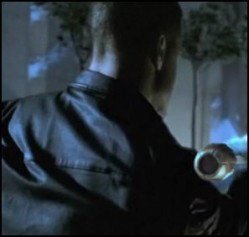NewTek has decided to integrate new technology gradually rather than dump old for new. It is the same dilemma faced by most software companies with older but popular products.
By Kathleen Maher
NewTek’s VP of 3D development Rob Powers has been doing the rounds visiting customers, the press and analysts to talk about the latest version of LightWave and the product’s roadmap going forward. Powers comes to LightWave as an avid user who has worked in TV and motion pictures. He put in years of his life on Avatar and helped develop the virtual filmmaking system used on the film, which is causing a revolution in the way films are made.
 Probably the major reason for the tour is to assure the 3D modeling and animation community that NewTek is deeply committed to LightWave and that the development team is working on a very attractive roadmap. Powers used the latest version of LightWave 10.1 to make his point.
Probably the major reason for the tour is to assure the 3D modeling and animation community that NewTek is deeply committed to LightWave and that the development team is working on a very attractive roadmap. Powers used the latest version of LightWave 10.1 to make his point.
The key features in the latest version include an updated and improved interface with more interactive controls such as channel sliders, more stereo 3D tools and control, better exchange tools, and probably the star of the release the Viewpoint Preview Renderer, VPR.
The VPR puts rendering inside modeling and animation workflow. It’s not longer stuck at the end of the process its an iterative piece of the design process. The is a key element in LightWave’s redesign, a process the company has been going through for several years. Previously, NewTek was trying to manage an extensive redesign of the product as a separate operation within the R&D team of LightWave and the new product was seen as a break from the LightWave line, introducing new workflows and formats.
The thinking was that it was impossible to update the old LightWave. Instead, it would be better to re-architect the product from the ground up. To that end, LightWave Core was developed as a separate line. Powers, when he came on a couple of years ago, reassessed and then beefed up the development team. The new thinking is that it makes more sense to implement new technology gradually and not break the LightWave continuum for loyal users.
Powers uses an example, the radical redesign of Softimage. He thinks that by the time the development team came through with a radical redesign of the product, the majority of the user base drifted off and they never came back.
So what’s new?
The interface and the VPR are probably the biggest most obvious changes because they affect workflow. The focus has been to improve interactivity and collaboration. For instance, the VPR’s ability to update renders quickly and produce an image that will closely resemble the finished render, gives everyone involved in a project the ability to see how a model is coming along and experiment with different lighting, textures, shaders, etc. It has been developed with the idea of fitting into new virtual filmmaking workflows, so its possible to use the viewport to explore locations, create quick but realistic walkthroughs, and place characters in the set. The new software has support for more than 10 interactive input devices being developed for virtual filmmaking including the 3DConnexion mouse.
LightWave also has beefed up support for stereo 3D workflows. Users can work with S3D files no matter what kind of rig was used to capture the data. The new S3D tools support parallel, toe-in, and off-axis rigs and lets users adjust interocular distance and convergence points within the VPR.
Another important workflow improvement comes from the addition of support for various file exchange strategies. LightWave was going the route of supporting Collada for file exchange, but users are much more frequently working with FBX, so this latest version of LightWave has improved FBX support and also support for Autodesk’s Geometry and Diffusion caching, in addition to LightWave’s own MDD which similarly allows geometry and diffusion to be baked into files.
The new LightWave also has improved fur and hair features, threading to improve the handling of large files, and the company has improved file handling to give users better control over backups and more logical structure to file trees.
What do we think?
The story of LightWave is a lesson for all software developers. The struggles of LightWave to update an old, product with a loyal following of users is one that is faced by many companies that brought out their products during the 90s—a magnificent time in software development. Some have died, unable to leap the chasm that developed with the introduction of new multi-core processors and now GPU compute and heterogeneous computing. As a matter of fact, a whole software industry is poised at the edge of that chasm. It’s a challenge that’s ongoing.
Companies that have not faced up to the need to fundamentally change programming approaches and take advantage of new architectures are going to fall drastically behind. Companies are taking a variety of approaches including parallel development teams. Not all companies are as forthright as NewTek has been, but many are facing the same challenges.
One of the advantages that Powers brings to the LightWave team is pragmatism. He’s trying to stay in touch with his roots as a content creator and to deliver the features that people need. Thus, there’s not a lot of pride about preferring open or homegrown technologies like Collada or MDD if what customers need is a good way to work with users using Maya and Motion Builder. It’s looking like the kind of attitude LightWave needs for the next phase of its life.





